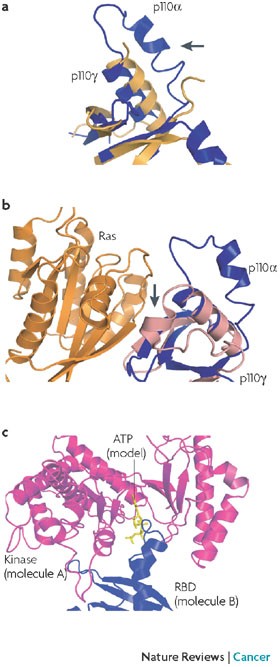
- Select a language for the TTS:
- UK English Female
- UK English Male
- US English Female
- US English Male
- Australian Female
- Australian Male
- Language selected: (auto detect) - EN
Play all audios:
ABSTRACT Class I phosphoinositide 3-kinases (PI3Ks) are lipid kinases that regulate cell growth. One of these kinases, PI3Kα, is frequently mutated in diverse tumour types. The recently
determined structure of PI3Kα reveals features that distinguish this enzyme from related lipid kinases. In addition, wild-type PI3Kγ differs from PI3Kα by a substitution identical to a PI3Kα
oncogenic mutant (His1047Arg) that might explain the differences in the enzymatic activities of the normal and mutant PI3Kα. Comparison of the PI3K structures also identified structural
features that could potentially be exploited for the design of isoform-specific inhibitors. Access through your institution Buy or subscribe This is a preview of subscription content, access
via your institution ACCESS OPTIONS Access through your institution Subscribe to this journal Receive 12 print issues and online access $209.00 per year only $17.42 per issue Learn more Buy
this article * Purchase on SpringerLink * Instant access to full article PDF Buy now Prices may be subject to local taxes which are calculated during checkout ADDITIONAL ACCESS OPTIONS: *
Log in * Learn about institutional subscriptions * Read our FAQs * Contact customer support SIMILAR CONTENT BEING VIEWED BY OTHERS PHOSPHOINOSITIDE KINASES IN CANCER: FROM MOLECULAR
MECHANISMS TO THERAPEUTIC OPPORTUNITIES Article 03 April 2025 STRUCTURAL BASIS OF PHOSPHATIDYLINOSITOL 3-KINASE C2Α FUNCTION Article Open access 07 March 2022 BEYOND PI3KS: TARGETING
PHOSPHOINOSITIDE KINASES IN DISEASE Article 14 November 2022 REFERENCES * Vanhaesebroeck, B. & Alessi, D. R. The PI3K–PDK1 connection: more than just a road to PKB. _Biochem. J._ 346 (Pt
3), 561–576 (2000). CAS PubMed PubMed Central Google Scholar * Bader, A. G., Kang, S., Zhao, L. & Vogt, P. K. Oncogenic PI3K deregulates transcription and translation. _Nature Rev.
Cancer_ 5, 921–929 (2005). Article CAS Google Scholar * Vivanco, I. & Sawyers, C. L. The phosphatidylinositol 3-kinase AKT pathway in human cancer. _Nature Rev. Cancer_ 2, 489–501
(2002). Article CAS Google Scholar * Katso, R. et al. Cellular function of phosphoinositide 3-kinases: implications for development, homeostasis, and cancer. _Annu. Rev. Cell Dev. Biol._
17, 615–675 (2001). Article CAS PubMed Google Scholar * Engelman, J. A., Luo, J. & Cantley, L. C. The evolution of phosphatidylinositol 3-kinases as regulators of growth and
metabolism. _Nature Rev. Genet._ 7, 606–619 (2006). Article CAS PubMed Google Scholar * Vogt, P. K., Bader, A. G. & Kang, S. Phosphoinositide 3-kinase: from viral oncoprotein to drug
target. _Virology_ 344, 131–138 (2006). Article CAS PubMed Google Scholar * Chang, H. W. et al. Transformation of chicken cells by the gene encoding the catalytic subunit of PI
3-kinase. _Science_ 276, 1848–1850 (1997). Article CAS PubMed Google Scholar * Li, J. et al. PTEN, a putative protein tyrosine phosphatase gene mutated in human brain, breast, and
prostate cancer. _Science_ 275, 1943–1947 (1997). Article CAS PubMed Google Scholar * Sansal, I. & Sellers, W. R. The biology and clinical relevance of the PTEN tumor suppressor
pathway. _J. Clin. Oncol._ 22, 2954–2963 (2004). Article CAS PubMed Google Scholar * Steck, P. A. et al. Identification of a candidate tumour suppressor gene, MMAC1, at chromosome
10q23.3 that is mutated in multiple advanced cancers. _Nature Genet._ 15, 356–362 (1997). Article CAS PubMed Google Scholar * Bachman, K. E. et al. The PIK3CA gene is mutated with high
frequency in human breast cancers. _Cancer Biol. Ther._ 3, 772–775 (2004). Article CAS PubMed Google Scholar * Broderick, D. K. et al. Mutations of PIK3CA in anaplastic
oligodendrogliomas, high-grade astrocytomas, and medulloblastomas. _Cancer Res._ 64, 5048–5050 (2004). Article CAS PubMed Google Scholar * Campbell, I. G. et al. Mutation of the PIK3CA
gene in ovarian and breast cancer. _Cancer Res._ 64, 7678–7681 (2004). Article CAS PubMed Google Scholar * Lee, J. W. et al. PIK3CA gene is frequently mutated in breast carcinomas and
hepatocellular carcinomas. _Oncogene_ 24, 1477–1480 (2005). Article CAS PubMed Google Scholar * Levine, D. A. et al. Frequent mutation of the PIK3CA gene in ovarian and breast cancers.
_Clin. Cancer Res._ 11, 2875–2878 (2005). Article CAS PubMed Google Scholar * Saal, L. H. et al. PIK3CA mutations correlate with hormone receptors, node metastasis, and ERBB2, and are
mutually exclusive with PTEN loss in human breast carcinoma. _Cancer Res._ 65, 2554–2559 (2005). Article CAS PubMed Google Scholar * Samuels, Y. et al. High frequency of mutations of the
PIK3CA gene in human cancers. _Science_ 304, 554 (2004). Article CAS PubMed Google Scholar * Vogt, P. K., Kang, S., Elsliger, M. A. & Gymnopoulos, M. Cancer-specific mutations in
phosphatidylinositol 3-kinase. _Trends Biochem. Sci._ 32, 342–349 (2007). Article CAS PubMed Google Scholar * Wang, Y., Helland, A., Holm, R., Kristensen, G. B. & Borresen-Dale, A.
L. PIK3CA mutations in advanced ovarian carcinomas. _Hum. Mutat._ 25, 322 (2005). Article CAS PubMed Google Scholar * Philp, A. J. et al. The phosphatidylinositol 3′-kinase p85α gene is
an oncogene in human ovarian and colon tumors. _Cancer Res._ 61, 7426–7429 (2001). CAS PubMed Google Scholar * Knight, Z. A. & Shokat, K. M. Chemically targeting the PI3K family.
_Biochem. Soc. Trans._ 35, 245–249 (2007). Article CAS PubMed Google Scholar * Pacold, M. E. et al. Crystal structure and functional analysis of Ras binding to its effector
phosphoinositide 3-kinase γ. _Cell_ 103, 931–943 (2000). Article CAS PubMed Google Scholar * Walker, E. H. et al. Structural determinants of phosphoinositide 3-kinase inhibition by
wortmannin, LY294002, quercetin, myricetin, and staurosporine. _Mol. Cell_ 6, 909–919 (2000). Article CAS PubMed Google Scholar * Walker, E. H., Perisic, O., Ried, C., Stephens, L. &
Williams, R. L. Structural insights into phosphoinositide 3-kinase catalysis and signalling. _Nature_ 402, 313–320 (1999). Article CAS PubMed Google Scholar * Miled, N. et al. Mechanism
of two classes of cancer mutations in the phosphoinositide 3-kinase catalytic subunit. _Science_ 317, 239–242 (2007). Article CAS PubMed Google Scholar * Huang, C. H. et al. The
structure of a human p110α/p85α complex elucidates the effects of oncogenic PI3Kα mutations. _Science_ 318, 1744–1748 (2007). Article CAS PubMed Google Scholar * Stephens, L. R. et al.
The G β γ sensitivity of a PI3K is dependent upon a tightly associated adaptor, p101. _Cell_ 89, 105–114 (1997). Article CAS PubMed Google Scholar * Suire, S. et al. p84, a new
Gβγ-activated regulatory subunit of the type IB phosphoinositide 3-kinase p110γ. _Curr. Biol._ 15, 566–570 (2005). Article CAS PubMed Google Scholar * Voigt, P., Brock, C., Nurnberg, B.
& Schaefer, M. Assigning functional domains within the p101 regulatory subunit of phosphoinositide 3-kinase γ. _J. Biol. Chem._ 280, 5121–5127 (2005). Article CAS PubMed Google
Scholar * Yu, J., Wjasow, C. & Backer, J. M. Regulation of the p85/p110α phosphatidylinositol 3′-kinase. Distinct roles for the N-terminal and C-terminal SH2 domains. _J. Biol. Chem._
273, 30199–30203 (1998). Article CAS PubMed Google Scholar * Carson, J. D. et al. Effects of oncogenic p110α subunit mutations on the lipid kinase activity of phosphoinositide 3-kinase.
_Biochem. J._ 409, 519–524 (2008). Article CAS PubMed Google Scholar * Bondeva, T. et al. Bifurcation of lipid and protein kinase signals of PI3Kγ to the protein kinases PKB and MAPK.
_Science_ 282, 293–296 (1998). Article CAS PubMed Google Scholar * Pirola, L. et al. Activation loop sequences confer substrate specificity to phosphoinositide 3-kinase α (PI3Kα).
Functions of lipid kinase-deficient PI3Kα in signaling. _J. Biol. Chem._ 276, 21544–21554 (2001). Article CAS PubMed Google Scholar * Kang, S., Bader, A. G. & Vogt, P. K.
Phosphatidylinositol 3-kinase mutations identified in human cancer are oncogenic. _Proc. Natl Acad. Sci. USA_ 102, 802–807 (2005). Article CAS PubMed PubMed Central Google Scholar *
Ikenoue, T. Functional analysis of PIK3CA gene mutations in human colorectal cancer. _Cancer Res._ 65, 4562–4567 (2005). Article CAS PubMed Google Scholar * Knight, Z. A. et al. A
pharmacological map of the PI3-K family defines a role for p110α in insulin signaling. _Cell_ 125, 733–747 (2006). Article CAS PubMed PubMed Central Google Scholar Download references
ACKNOWLEDGEMENTS Support was provided by the Virginia and D. K. Ludwig Fund for Cancer Research, NIH grants CA43460 to B.V., GM066895 to L.M.A, and GM07309 and GM07184 to D.M. AUTHOR
INFORMATION Author notes * L. Mario Amzel and Chuan-Hsiang Huang: L.M.A and C.-H.H. contributed equally to this work. AUTHORS AND AFFILIATIONS * Chuan-Hsiang Huang and Sandra B. Gabelli are
at the Department of Biophysics and Biophysical Chemistry,Johns Hopkins University School of Medicine, L. Mario Amzel, 725 North Wolfe Street, Baltimore, Maryland 21205, USA., L. Mario
Amzel, Chuan-Hsiang Huang & Sandra B. Gabelli * Chuan-Hsiang Huang is at the Graduate Program in Immunology, Johns Hopkins University School of Medicine, 725 North Wolfe Street,
Baltimore, Maryland 21205, USA., Chuan-Hsiang Huang * Diana Mandelker, Christoph Lengauer and Bert Vogelstein are at the Ludwig Center for Cancer Genetics and Therapeutics, and The Howard
Hughes Medical Institute at The Johns Hopkins Kimmel Cancer Center, 1,650 Orleans Street, Baltimore, Maryland 21231, USA., Diana Mandelker, Christoph Lengauer & Bert Vogelstein *
Christoph Lengauer is currently at the Novartis Institutes for BioMedical Research, 250 Massachusetts Avenue, Cambridge, 02139, Massachusetts, USA Christoph Lengauer Authors * L. Mario Amzel
View author publications You can also search for this author inPubMed Google Scholar * Chuan-Hsiang Huang View author publications You can also search for this author inPubMed Google
Scholar * Diana Mandelker View author publications You can also search for this author inPubMed Google Scholar * Christoph Lengauer View author publications You can also search for this
author inPubMed Google Scholar * Sandra B. Gabelli View author publications You can also search for this author inPubMed Google Scholar * Bert Vogelstein View author publications You can
also search for this author inPubMed Google Scholar CORRESPONDING AUTHOR Correspondence to Bert Vogelstein. ETHICS DECLARATIONS COMPETING INTERESTS Under agreements between the Johns Hopkins
Universtiy and Exact Sciences, Inc., B. V. is entitled to a share of the royalties received by the University on sales of products related to PIK3CA mutations. The University and B. V. also
own stock in Exact Sciences, Inc., which is subject to certain restrictions under University policy. The terms of these arrangements are being managed by the University in accordance with
its conflict of interest policies. SUPPLEMENTARY INFORMATION SUPPLEMENTARY INFORMATION S1 (FIGURE) (PDF 342 KB) SUPPLEMENTARY INFORMATION S2 (FIGURE) (PDF 963 KB) RELATED LINKS RELATED LINKS
DATABASES NATIONAL CANCER INSTITUTE brain tumour breast cancer colon cancer liver cancer ovarian cancer FURTHER INFORMATION L. Mario Amzel's homepage RIGHTS AND PERMISSIONS Reprints
and permissions ABOUT THIS ARTICLE CITE THIS ARTICLE Amzel, L., Huang, CH., Mandelker, D. _et al._ Structural comparisons of class I phosphoinositide 3-kinases. _Nat Rev Cancer_ 8, 665–669
(2008). https://doi.org/10.1038/nrc2443 Download citation * Published: 17 July 2008 * Issue Date: September 2008 * DOI: https://doi.org/10.1038/nrc2443 SHARE THIS ARTICLE Anyone you share
the following link with will be able to read this content: Get shareable link Sorry, a shareable link is not currently available for this article. Copy to clipboard Provided by the Springer
Nature SharedIt content-sharing initiative






